
Yuan Shao Tomb
Yuan Shao was the grandson of Emperor Xiaowen of Northern Wei and the second son of Prince Wenxian of Qinghe, the Prime Minister. In the 1st year of Wutai (528), Yuan Shao was killed in the Riot of Heyin at the age of 23. After his death, he was made “Palace Attendant, Minister of Education, Great General of Cavalry and Governor of Dingzhou” and entitled posthumously Prince of Wengong. Then he was buried “on Huanggang Mound two li to the east of the Chanshui River.”
Yuan Shao’s Tomb was raided earlier. Later most of the stolen cultural relics were recovered. In 1965, Luoyang Museum carried out a clearing excavation. It is located on a slope of the Mangshan Mountains, 4 kilometers to the northeast of the old town of Luoyang and 0.25 kilometers to the south of Panjiazhong Village. The tomb, with no mound, is an earthen cave tomb with a long sloping passage. The cultural relics unearthed and recovered total over 120, including 107 pottery human figurines of officials, warriors, musicians, attendants, etc.; 8 animal figurines of a horse, donkey, pig, ox, camel and tomb beasts; 10 pottery life implements including bowls, plates, lamps and cases. Besides, an inscribed tombstone was also discovered in the passageway.
Does the “Kunlun slave” figurine really represent a “Kunlun slave”? Do you have any other hypothesis as to the ethnic origin of the man the figurine represents? Does his head-on-knees posture shed light on his loneliness on an alien land? Or is he mourning the dead?
Your answer please, if you have any questions or answer, please feel free to send us email, we are waiting for your answers and participation, and your comments, answers and suggestions will be highly appreciated. We will select and publicize the most appropriate answers and comments some time in the future.
Weekly Selection Email: meizhouyipin@chnmus.net
We cannot view the foreigner figurines discovered in tombs as reflections of the real foreigners. They are just highly summative images. What care more about is: What roles these foreigners play in tombs? In what way are they significant?
As represented, the Kunlun slave rests his head on the knees, seemingly melancholy, weary and with a sense of inferiority. An overview of the foreigner figurines of different dynasties that have been unearthed, the foreigners’ features are often very conspicuous, particularly in the Tang Dynasty figurines. Moreover, artisans were good at representing their status and emotions. As most of the foreigners were low in status, they have, in most cases, been represented as guards of honor, attendants, musicians, gymnasts, travelling merchants, etc. More often than not, they look worried, anxious and lacking in confidence. [[]] In his Ode to Lingguang Hall of Lu, Wang Yanshou of the Han Dynasty describes foreigners as “looking sad and worried”. Li Bai and Du Fu also describe “foreigners” as despondent in their poems.
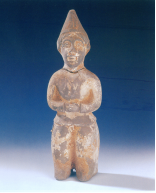
Han and Jin foreigner figurines have not been found in great numbers and are often rather coarse. For instance, the foreigner figurine unearthed in a Jin tomb in the west of Luoyang represents the foreigner as an attendant with deep-set eyes and a high nose and wearing a pointed hat (Fig. 7). Though Northern Wei foreigner figurines are not as large in number or vivid as those of the Sui and Tang dynasties, they are more diversified than the earlier dynasties, representing carriage drivers, attendants, dancers, camel leaders, musicians, performers, etc. (Fig. 8, Fig. 9 and Fig. 10)
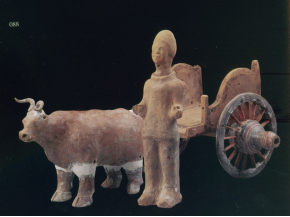
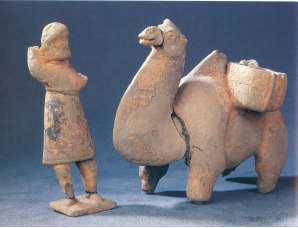
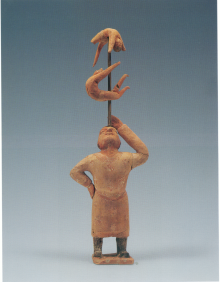
Besides, we can interpret the Kunlun slave figurine as a work through which the tomb owner expresses his sorrow and melancholy. There are no rules for this type of figurine. However, we can find comparable examples discovered in tombs.
A set of pottery figurines has been unearthed in Han Tomb No. 1 at Wulou, Yanggu, Shandong. As represented, they are weeping bitterly, either face up or down. The excavation report says that the figurines represent “wailing mourners”. Some scholars believe that the set is associated with the funeral custom then. [[]] In the collection of Henan Museum, there is a Sui Dynasty woman figurine. She sits on the ground. With the head tilting slightly to the left with cheek on the right hand and her eyes looking down, she looks sorrowful in meditation. Thus the figurine has been named Woman in Grief and Meditation. Some scholars think that figurines of this type were created to mourn the dead. [[]] (Fig. 11) A similar example is a “weeping woman” figurine unearthed in Wang Chen’s Tomb in Changzhi, Shanxi. As represented, the woman bends over, with hands on knees. She looks very sad, as if mourning the tomb owner. (Fig. 12) There is another figurine representing a foreign-looking woman sitting sideways on a camel. She bends over a hump, her face covered by the right arm. Though the figurine is named “Resting Woman” Figurine, given it has been discovered in a tomb, it is not far-fetched to say that she is mourning. (Fig. 13)
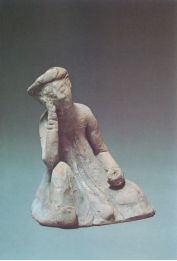
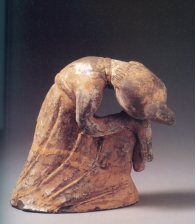
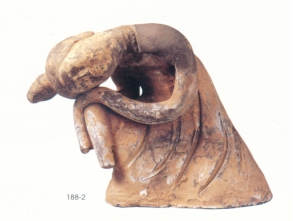
Fig. 12 Wailing Woman, Tang Dynasty, Unearthed in 1954 in Wang Chen’s Tomb, Changzhi City, Shanxi Province
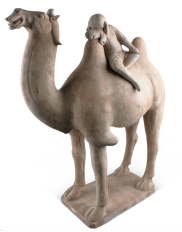
Therefore, the images of foreigners in tombs are not necessarily realistic representations. Whether the figurine discovered in Yuan Shao’ Tomb of Northern Wei represents a foreigner or “Kunlun slave” is not that important. What is important is that we can see the Chinese people’s imagination of foreigners and their creativity.
Strictly speaking, we have not enough evidence to prove for certain that this sitting pottery figurine is a Kunlun slave figurine. Foreigner figurines with curly hair and beard, a high nose and deep-set eyes, which have been discovered in tombs, mostly represent foreigners from Central or Western Asia. As written in A General Survey of Dayuan in Records of the Grand Historian, “Though the countries west of Dayuan to Anxi speak different languages, they have roughly the same customs and can understand each other’s languages. The people there have deep-set eyes and most of them wear a curly beard. They are good at trade and particular about petty gains.” The chapter The Western Regions in History of Wei mentions the people of Sogdiana, saying, “The people all have deep-set eyes and a high nose and are bearded.”
After Emperor Taiwu of Northern Wei seized control of the northwest, he resumed foreign exchange that had been discontinued for many years. The countries in the Western Regions established close ties with Northern Wei either by paying tributes or doing business. As written in Temples in Luoyang (Luo-yang-jia-lan-ji), “The numerous countries and cities from Pamirs westward to Cippus have all gladly submitted themselves. Foreign merchants and guests flood to the border passes. It can be safely said that all other peoples different from us can be found here. They come to love local customs in China. Those who settle here out of this love are innumerable…”[[]] It demonstrates the great multitude of the foreigners in Luoyang City in the Northern Wei Dynasty.
A dozen of Northern Wei foreigner figurines have been unearthed in Luoyang, representing attendants, dancers, camel/horse and groom, etc. Most of them wear a small round hat and feature deep-set eyes, a high nose, curly hair and beard. The “Kunlun slave” figurine unearthed in Yuan Shao’s Tomb also has curly hair and wears the same costume as the foreigner figurine discovered in Wang Wen’s Tomb of Northern Wei. Their pants are tucked into their boots which share the similar wrinkles or leggings). So this figurine must represent a typical Western foreigner. (Fig.3)
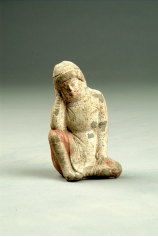
Why do some scholars name it “Kunlun slave figurine”?
Kunlun does not refer to a country or an ethnic group, but roughly ranges from regions including what are now the islands in the South China Sea to some regions by the Indian Ocean. Kunlun first appears in Exotic Things in the South (Nan-zhou-yi-wu-zhi) by Wan Zhen of Wu in the Period of the Three Kingdoms. The term can often be found in later histories and literary sketches of various types in the Tang Dynasty, when Kunlun people were often trafficked into the two capitals(Chang’an and Luoyang) and served as slaves and musicians. They were often referred to as Kunlun slaves and always in short supply in the market. The possession of Kunlun slaves became a symbol of status.
As for the appearance and dress of Kunlun people, Sketches of Funan in History of Jin (Funan refers to what is now Southeast Asia) writes, “[The people] are all ugly and dark-skinned. With curly hair, they are usually naked and walk around barefooted.” The poem, Kunlun Man, by Zhang Ji of the Tang Dynasty says, “…Golden earrings pierce through their ears; with long curly hair forming a conch-like bun, they never cover up their head. They love their pitch-black skin. When they walk they are half naked in kapok dress…” It shows that Kunlun people are dark-skinned and that they wear a conch-like bun with curly hair and bare their body and feet. Such description has been verified by Tang tomb figurines. (Fig.4)
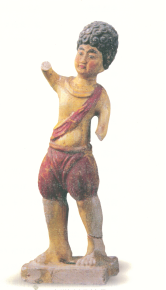
So far we have not discovered any images of Kunlun people on Northern Wei relics. However, in the portraits of foreign envoys by Xiao Yi, a famous painter of the contemporary Liang Dynasty (502-557), it can be seen that the “envoy from the State of Langyaxiu” in the South Sea fits with the description in the relevant literature. [[]] (Fig. 5)
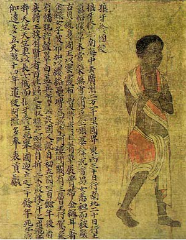
The small “Kunlun slave” tomb figurine discovered in Yuan Shao’s Tomb of the Northern Wei Dynasty has thick curly hair—the only feature consistent with the description of Kunlun slaves. It is indeed the part the artisan highlighted. As far as dress is concerned, the robe, trousers and boots he wears do not fit with the typical dress style featuring the bared body and feet. However, an overview of the Kunlun slave figurines of different dynasties that have been unearthed has shown that some of them do wear a robe and boots. Such is the case with a Tang Dynasty “Kunlun slave” figurine in the collection of the Palace Museum in Beijing. (Fig. 6) Since no other figurine of the same type has been founded in tombs of the Northern Dynasties so far, further research needs to be conducted as to the identity of this “Kunlun slave”.
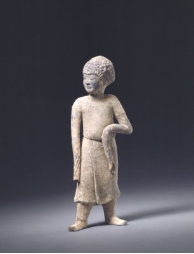
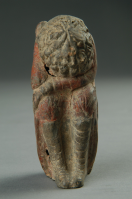
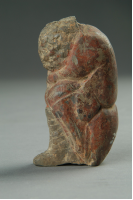
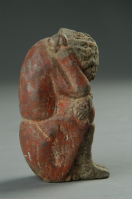
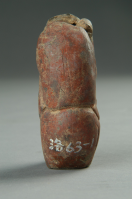
Fig. 1 “Kunlun Slave” Figurine Viewed from Different Angles
As represented by the small colored pottery figurine, the “Kunlun slave” sits with legs closed and the left arm on the knees. His head down and the right hand on the back of the neck, his entire body curls up together when viewed from sideways. As for his clothes, he wears a long robe with a waist belt, trousers and long boots. His body is painted red. The curly hair is the only indicative clue of man’s identity: he was likely to be an “alien” who had come from afar. (Fig.1)
The pottery figurine was unearthed in a Northern Wei tomb in Beimang, Luoyang, which belonged to Yuan Shao[[]] (528 CE), grandson of Emperor Xiaowen of the Northern Wei Dynasty. Though the colored pottery figurine is less than 10 centimeters tall, it is very special. Of all the Northern Wei pottery figurines discovered so far, it is unique in form. When it was discovered, there had been disagreement on its naming. The excavation report calls it “child figurine” (tong-yong), or more generally “foreigner figurine” (hu-yong). Currently the most widely accepted name is “Kunlun slave figurine”. This has aroused our immense interest in the small pottery figurine.
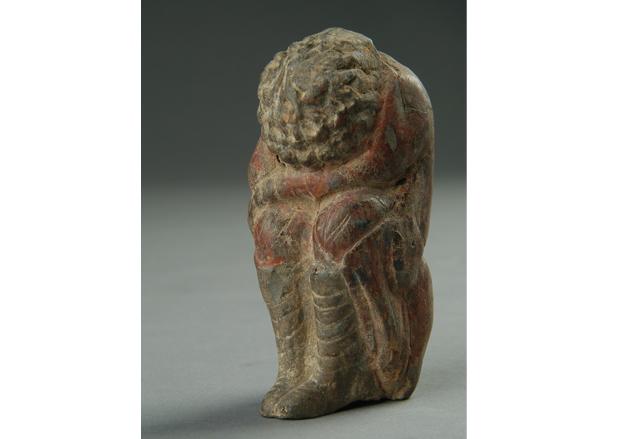
The Colored Pottery Figurine of the “Kunlun Slave”, 9.5 centimeters tall, was made in the Northern Wei Dynasty and unearthed in Yuan Shao’s Tomb at Longzhong Village, Laochengpan, Luoyang. Now it is in the collection of Luoyang Museum.